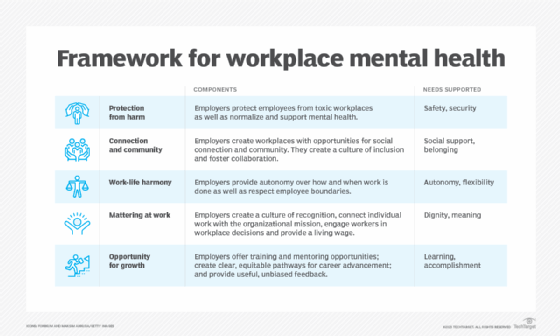
Mental health statistics and their impact on the workplace
Amid lingering mental health effects of the COVID-19 pandemic, organizations look to support employees. Tech shows promise for improving the root causes of work wellness issues.
Although the peak of the COVID-19 pandemic has subsided, it has left a lasting mark on workers' mental health. The longest-lasting effect of the pandemic has been the psychosocial impact. But technology can play a pivotal role in workplace well-being.
Workers and businesses alike are facing a notable rise in mental health issues such as depression, anxiety and substance use disorder among employees. While in 2022 44% of employers observed a surge in these concerns, that number jumped to 77% in 2023. Additionally, 16% of employers expect a further increase in the future, according to a 2023 Business Group on Health survey.
"That's where you get all the cumulative trauma of the pandemic. You end up with high rates of burnout in the workforce, economic injury and its impact on mental health. Essentially, the world has just been moving through that final wave of the pandemic over the last couple of quarters. We saw record low levels of mental health all over the world, and in the U.S., it was particularly bad. But I think we might be coming out of that," said Aaron McEwan, vice president of research and advisory at Gartner.
Response to mental health needs
Organizations are responding to the need for workplace mental health services. "In response to the COVID-19 pandemic, 70% of companies introduced new well-being benefits or increased the amount of existing well-being benefits. Ninety-six percent of companies today are offering mental well-being programs," McEwan said, citing Gartner research.
Organizations also have added support from the federal government. The first-ever Surgeon General's Framework for Workplace Mental Health and Well-Being was released in 2022. The goal of the framework is to support workplaces as "engines of well-being" that perpetuate wellness in the workplace.

While there's been a positive shift, more work is needed. Many employees aren't using the offered support. Traditional remedies such as yoga, mindfulness and resilience training don't address the root causes of workplace burnout and mental health challenges. They may even add stress to employee's already-busy workday.
"What we're seeing now is organizations taking a more preventative approach to mental health. They're beginning to recognize that the real root causes of poor mental health in the workplace like poor work design, under-resourced teams, people working longer hours than they should be …" McEwan said.
Data from the 2023 APA Work in America survey shows that these root causes undermine the essential needs laid out in the Surgeon General's Framework for Workplace Mental Health:
- Only 40% of workers reported that their time off was respected, showing a lack of work-life harmony.
- People who feel that their work is not meaningful are more likely to report being stressed during the workday. 45% of survey respondents who said their work was meaningful reported feeling stressed during the workday compared to 71% who said their work was not meaningful.
- Workers who reported good or excellent mental health reported significantly higher satisfaction with growth opportunities, which stresses the need for sufficiently resourced teams. 79% of workers satisfied with growth opportunities reported good or excellent mental health. 52% of workers unsatisfied with growth opportunities reported good or excellent mental health.
Technology's role
Emergent technology may give employees the opportunity to volunteer more specific work experience data through job board platforms and tracking applications. Organizations can then take a more preventative approach and turn workplaces into "engines of well-being," get to the root causes of mental health issues and support employee needs in line with the Surgeon General's Framework.
AI also shows promise in helping organizations respond to these root causes. While automation and AI often raise concerns about job loss, they show promise for job creation and improvement. “Generally speaking, we find that these types of technologies end up creating more jobs generally than they destroy,” McEwan said. McEwan went on to explain that one way AI can improve mental health in the workplace is by improving job design. AI can ensure employees are completing tasks that engage and fulfill them by reducing mundane, tedious tasks to give employees more autonomy and flexibility. Additionally, on the experimental end, emerging technologies can be used to monitor the mental and emotional impact of work on employees with tools such as sentiment analysis.
Smartwatches and other wearable technology may also play a larger role in the ability of organizations to provide preventive mental health offerings to their employees with more detailed insights and data to report. "One of the things we're starting to see is employees using that type of technology to monitor the impact of their jobs on their own health and making decisions based upon that data. So you might decide to quit a job because your personal tracking data is showing you that it's not good for your health," McEwan said.
Employees and data aggregators would then be able to share these insights on job recruitment platforms in the same way they traditionally volunteer personal accounts of work experience. "The Glassdoors of the future are more likely to use aggregated smartwatch data. You could get a list of the companies with the lowest average resting heart rate or companies whose employees have optimal sleep or [those who have the] happiest employees. That kind of future is approaching very quickly," McEwan said.
This hypothetical future would be dependent on organizations providing that equipment to their employees. In some industries, this is already a reality. "The use of tracking technology within safety is well established. It's been around for more than 10 years. Some of the largest mining companies in the world will use caps that their employees wear to track the risk of microsleep, which helps them avoid falling asleep while driving equipment on a mine site, for example," McEwan said.
Employees want to share and consume information about working conditions on platforms such as Glassdoor, Reddit and TikTok. "I think what's missing at this stage [is that] there is no way for employees to necessarily share their own data with an aggregator site. We know at this stage that 56% of employees are consuming employee-generated information about their work and their employer. Fifty-two percent of employees surveyed would be willing to share their anonymized wellness data in public forums like Glassdoor," McEwan said, referencing data from the 2023 Gartner Employee Perspectives on the Future of Work survey.
More than half of employees would decide about whether to apply for a job if they could see that data, and 46% would be influenced by influenced about whether to stay in a job by that data, according to the same study.
Employers look to build trust
"Those organizations that create healthy environments and take care of their employees are going to continue to have the [most] access to the best talent," McEwan said.
Although more than half of employees would be willing to give aggregators anonymized health data to improve job insights, employees need to trust their managers and employer. "Employees won't give you that data unless you use it to improve the workplace and work experience. People are pretty happy to give organizations their data if it gives them a better experience as a customer. Organizations will have to be clear what they're collecting, how they're using it, what decisions it's influencing and what the benefits are to those employees," McEwan said.







